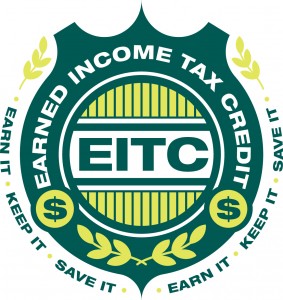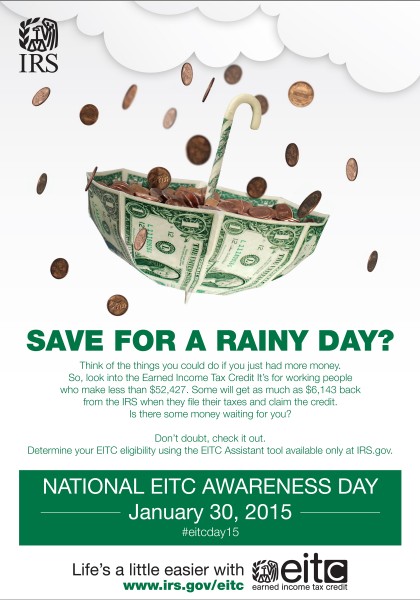
A Hand Up for Lower-Income Families
Welfare queens driving Cadillacs. Food stamp kings buying filet mignon. The stereotypes are rife. What if there was a way to support lower-income families without the stigma? There is. And it comes from an unexpected source: the Internal Revenue Service.
First, listen to how Tracy Sherman, a 28-year-old medical coder and single mother of two, described her time on Temporary Assistance for Needy Families (TANF), which provides means-tested cash assistance (known colloquially as “welfare”). Right after her youngest daughter was born, the baby’s father, an alcoholic, relapsed, and Tracy turned to TANF, feeling she had no other options. “I didn’t feel good as a person…. They gave me [cash] plus they gave me food stamps for formula and everything like that. And every time I used it, I felt like crap.” Now listen to Tracy’s anticipation of her tax refund check, made up largely of government transfers. “I think about [the refund] all year long… It’s like, ‘Oh, I can’t wait until I get my tax money!’” While Tracy said the $800 a month she received from TANF was not “really worth it,” the $3,500 she received as a tax refund—a far smaller sum of money—fueled her dreams all year long.Each year the Earned Income Tax Credit (EITC) and the Child Tax Credit (CTC) lift some five million children above the poverty line. The EITC has been credited with increasing employment, particularly among less-educated single mothers. And that’s not all: the EITC has been tied to mothers receiving more prenatal care and being less likely to smoke and drink during pregnancy; in turn, their babies are less likely to be born low birth weight or preterm. The benefits for kids continue past infancy, with the children of EITC recipients being more likely to earn higher grades, graduate high school, and enroll in college (Chuck Marr’s research provides a review of the benefits associated with the EITC). All this without the humiliation and shame so many describe experiencing when receiving other means-tested cash and in-kind benefits.
Who qualifies for this program? The EITC is a refundable tax credit available to low-income workers, with its size determined by marital status, number of dependent children, amount of earnings and job status. For low-income workers without dependent children, only a small refund is available. The vast bulk of EITC payments go to parents who work but are still poor. As their incomes rise, so do benefits, with the maximum refund for a single parent of two—$5,548 delivered in one check at tax time—for those earning between $13,870 and $18,110 in 2015.
The average EITC for families with children is about $3,000. In addition, the Child Tax Credit offers up to $1,000 per child, depending on earnings, to those with kids under 17. Many EITC recipient families also benefit from the refundable portion of the CTC, making for quite a substantial refund check at tax time. A single mother of two working full-time at minimum wage can receive the equivalent of more than three months of earnings in her tax refund, pushing her annual income above the poverty line.To learn more about what role the EITC plays in the lives of working families, we sat in the lobbies of H&R Block tax prep offices and prepared taxes at Volunteer Income Tax Assistance sites in Boston, meeting parents like Tracy as they filed their taxes. After tax time ended, we visited Head Start centers across the metropolitan area to ensure we’d find those parents who filed taxes themselves or used the services of a tax-savvy uncle or friend. Through short surveys with over 300 parents, we learned how much they expected to get back as a tax refund and how they planned to use the money. We then drew a sample for in-depth interviews meant to capture a diversity of black, white, and Hispanic families and married and unmarried parents; all were EITC recipients who had received at least $1,000 as a tax-time refund. While few were currently receiving TANF benefits, nearly half had done so at some point in the past, and the vast majority was currently receiving some form of government assistance, like SNAP (formerly known as food stamps) or subsidized housing. This allowed us to contrast the tax refund experiences they described with their perceptions of other government assistance programs.
 Six months after tax time, we sat down with 115 parents, typically in their homes, to learn about their finances and the role the tax time windfall played in their lives. We solicited details on everything from how much they spent on groceries, to how much they earned braiding hair, to how much an ex handed over in child support each month. And, perhaps more importantly, we explored what this money meant to parents: the stress of living with debt, the disappointment of not being able to come through for the kids with presents at birthdays or Christmas, and the feelings of jubilation and hope that tax time elicits.
Six months after tax time, we sat down with 115 parents, typically in their homes, to learn about their finances and the role the tax time windfall played in their lives. We solicited details on everything from how much they spent on groceries, to how much they earned braiding hair, to how much an ex handed over in child support each month. And, perhaps more importantly, we explored what this money meant to parents: the stress of living with debt, the disappointment of not being able to come through for the kids with presents at birthdays or Christmas, and the feelings of jubilation and hope that tax time elicits.
Immersed in research on the stigma recipients often experience when participating in TANF (and its predecessor, Aid to Families with Dependent Children [AFDC]), SNAP, and government housing programs, we were struck by what we heard from EITC-recipient parents. Government assistance could actually be means-tested and socially incorporating, rather than ostracizing. Decades of qualitative research, such as Kathryn Edin and Laura Lein’s Making Ends Meet and public opinion polls, such as those discussed by Martin Gilens in Why Americans Hate Welfare, have documented the shame associated with TANF/AFDC receipt, both on the part of recipients themselves and the public at large. Economist David Ellwood and political scientist Kent Weaver have explained that this is due, in part, to perceptions of such support as inconsistent with the widely-shared American values of work, family, and self-reliance.
And while politicians on both sides of the aisle have decried the nation’s means-tested cash assistance programs, particularly prior to the 1996 welfare reform, both Republicans, like President Reagan and Speaker Ryan, and Democrats, like Presidents Clinton and Obama, have heartily endorsed the EITC. Michael Katz, historian of the American welfare state, noted that the EITC enjoys strong political and popular support because it serves working Americans, lifting up those who are seen as keeping up their end of the social contract; this contrasts with a program like TANF, which targets those who are marginally tied to the labor market. Further, research by political scientists finds that the American public prefers benefit programs that are administered via tax credits over direct spending. Unlike many other forms of government assistance to low-income families, the EITC is in line with these preferences. Although tax refunds do not meet all the needs of low-income workers—and they only assist those who are able to find and keep jobs—this method of delivering financial support offers a blueprint for how social assistance programs can provide a hand up without a perceived slap on the wrist.
In our study, the way parents talked about their tax refunds revealed the connection they saw between these benefits and their work effort. This is an intentional part of the law: When President Clinton oversaw the massive expansion of the EITC in the early 1990s, he noted that it had the power to “make work pay.” Like most of us, EITC beneficiaries are fuzzy on the details of the tax code, but they know they get a large refund because they have kids, they work, and they don’t earn a lot. The refund, therefore, affirms their core, positive identities as workers and parents. Parents told us their jobs often offered little by way of pay, status, or career mobility; the reward at tax time was, therefore, particularly welcome.
The way parents apply for and receive the EITC is distinct from the process for other means-tested benefits. The words “Overseers of the Public Welfare” are emblazoned above the now-empty home of East Boston’s old AFDC office, implying that those making a claim to means-tested cash assistance require monitoring. In contrast, H&R Block’s slogan is seen as a welcoming promise: “You’ve got people!” Unlike applying for TANF, the EITC and CTC application and delivery come through the tax system, which is universally used up and down the income ladder, making it less stigmatizing. Most Americans do not use an Electronic Benefit Transfer card at the supermarket; most Americans do not live in public housing; most Americans do not have to lay bare their lives to a caseworker to get cash welfare; but most Americans do file taxes each year, and most receive a refund check. In fact, Suzanne Mettler’s research in The Submerged State shows that nearly half of EITC recipients in her survey reported not taking part in any government social programs; this illustrates the disconnect we saw in our qualitative study between EITC receipt and feeling like a proverbial “taker.” Unlike so many other government programs, then, assistance via the tax system does not make EITC beneficiaries feel they are marked as anything other than American. The arrival of the refund check at tax time gave families the opportunity to dig out of debt, pay ahead on bills, and stock up on food. While there are some myths or assumptions that low-income families will blow the lump sum on big screen TVs or fancy sneakers, we saw that these stereotypes were far from the norm. Tracy explained, “You’re thinking of all crazy things that you [could] spend it on…. But, I mean, realistically it comes at a good time, at that point where ‘Okay, I need to pay bills,’ and everything comes in perspective of what is a priority.” Like Tracy, respondents in our study spent most tax refund dollars on the mundane necessities of daily life—toilet paper, cleaning supplies, groceries—and getting caught up on bills and paying down debts—credit cards, utility bills, medical debts, student loans. Some saved a part of their refund, mostly to smooth income when the all-too-common “rainy day” arrives. Much of the rest goes to durable goods like used cars, furniture, and appliances.
The arrival of the refund check at tax time gave families the opportunity to dig out of debt, pay ahead on bills, and stock up on food. While there are some myths or assumptions that low-income families will blow the lump sum on big screen TVs or fancy sneakers, we saw that these stereotypes were far from the norm. Tracy explained, “You’re thinking of all crazy things that you [could] spend it on…. But, I mean, realistically it comes at a good time, at that point where ‘Okay, I need to pay bills,’ and everything comes in perspective of what is a priority.” Like Tracy, respondents in our study spent most tax refund dollars on the mundane necessities of daily life—toilet paper, cleaning supplies, groceries—and getting caught up on bills and paying down debts—credit cards, utility bills, medical debts, student loans. Some saved a part of their refund, mostly to smooth income when the all-too-common “rainy day” arrives. Much of the rest goes to durable goods like used cars, furniture, and appliances.
Meanwhile, in the weeks and months following receipt of the EITC, parents in our study described enjoying the small luxury of being able to put items in the shopping cart without an eye on the price comparison between name and store brand. They talked about the relief that came from making real progress digging out from under debt. Among those who put any refund dollars toward debt, the modal parent reduced her debt burden by about half. Some were able to save themselves from eviction, keep the lights from being shut off, get caught up on their student loans, start repairing their credit, and stop the harassing phone calls from creditors. Michelle and Jonah Tavares were a young couple with a baby son; both worked, but making ends meet remained a challenge. Michelle described their thinking when the refund check came: “We had to pay stuff that we knew would get shut off. I mean, you know you have other bills to pay, but you have to think of basic needs for your kid, you know. I have to think about his shelter and stuff. You go and pay your electricity because you want to have light.” In short, tax time meant escaping some of the material hardship and easing some of the psychological pressure of living on the financial edge, even if such difficulties would return later in the year.

Parents only spent about one refund dollar in ten on treats, like meals at a sit-down restaurant, vacations, children’s toys, and the like. But the chance to indulge in these items and experiences was more than a matter of dollars and cents. Spending on treats made them feel like they were able to fulfill their roles as parents as they wished they could all year round. Tamara Bishop, a 33-year-old assistant preschool teacher, described taking her kids to the movies and letting them buy movie-theater popcorn. What may be a routine rainy-day activity for wealthier families was a special treat for the Bishops. In a consumer culture such as ours, missing out on these little luxuries can make it feel like you’re standing on the outside looking in. Extra money in your pocket means you can get off the sidelines and get in the game. Though this increased spending was small in absolute dollars and short-lived, it was symbolically meaningful to parents. As one mother put it, it makes you feel like “real Americans.”
Yet another benefit of the refund check comes not in how it is spent, but in the hope it fuels. This massive infusion of cash made the parents we interviewed feel they could dream about a brighter future, one in which a refund check could be turned into a down payment on a home, a nest egg, or even a dream trip to Disney World. Though such dreams rarely come to pass, with more mundane concerns demanding attention, the hope offered by the refund is a benefit in and of itself. Recall Tracy, who enjoyed the flights of fancy anticipating the refund check allowed; while she ultimately spent her refund on necessities, she relished the chance to daydream about a life in which she could buy herself a new laptop. The laptop itself isn’t the prize here; rather, the refund’s existence buys Tracy a bit of middle-class fantasizing, a welcome break from the penny pinching of her regular life. Or take, for example, parents’ tendency to pay down debt with the refund. They explained that repairing their credit was one way they were moving toward their goal of becoming homeowners. A good credit score would put them in a better position to apply for a mortgage, they said; then, they could save next year’s refund check as part of a future down payment. Pedro Rios and his wife Agustin were one such family. Pedro told us, “We’re trying to save [next year’s refund]…. In order to be a family, we want to get a house.” Even if the home purchase never comes to pass, feeling as though you’re on the path to owning a home of your own makes you feel like you’re that much closer to securing your piece of the American dream.
Unlike TANF or SNAP, government assistance via refundable tax credits tends to fly under the public radar. Yet, while only some 1.8 million families receive TANF benefits, more than 27 million receive the EITC. Recipients perceive neither the social meanings of these tax refunds nor their method of delivery as stigmatizing. The programs’ material, psychological, and social consequences are incorporating, making people feel a part of, rather than apart from, mainstream society. The refund fuels dreams of upward mobility and a more comfortable, middle-class life, providing hope for low-income working parents who are often scraping by day-to-day to cover necessities. There are, of course, drawbacks to refundable tax credits: they’re of little help to those without jobs or dependent children, for example, nor do they fully address the financial needs of those they serve. Nonetheless, they offer a model for how government assistance can strengthen families financially, psychologically, and socially, with positive consequences for future generations.The refund fuels dreams of upward mobility and a more comfortable, middle-class life, providing hope for low-income working parents who are often scraping by day-to-day to cover necessities.Recommended Resources:
Chuck Marr, Chye-Ching Huang, Arloc Sherman, and Brandon DeBot. 2015. “EITC and Child Tax Credit Promote Work, Reduce Poverty, and Support Children’s Development, Research Finds.” Washington, D.C.: Center on Budget and Policy Priorities. A brief overview of how the EITC and CTC work and their effects on beneficiaries.
Nada Eissa and Hilary W. Hoynes. 2006. “Behavioral Responses to Taxes: Lessons from the EITC and Labor Supply,” Tax Policy and the Economy 20:73-110. Studies the work-inducing nature of the EITC, finding that the program brings single mothers into the labor market but has limited effects on how much employees work.
Laura Tach and Sarah Halpern-Meekin. 2014. “Tax Code Knowledge and Behavioral Responses Among EITC Recipients: Policy Insights from Qualitative Data,” Journal of Policy Analysis and Management 33:413-439. How and why EITC recipients do and do not respond to the incentive structures in the EITC, including whether they alter work behavior, marriage decisions, and childbearing.
Ruby Mendenhall, Kathryn Edin, Susan Crowley, Jennifer Sykes, Laura Tach, Katrin Križ, and Jeffrey R. Kling. 2012. “The Role of the Earned Income Tax Credit in the Budgets of Low-Income Households,” Social Service Review 86:367-400. How parents spend their tax refund dollars, including allocations to current consumption, asset accumulation, and debt repayment offers essential information about how the EITC functions as part of lower-income families’ financial portfolios.
Jennifer Sykes, Katrin Križ, Kathryn Edin, and Sarah Halpern-Meekin. 2015. “Dignity and Dreams: What the Earned Income Tax Credit (EITC) Means to Low-Income Families,” American Sociological Review 80:243-267. Explores the social inclusion created by the EITC, in contrast to the stigma engendered by welfare receipt.

Comments 1
Michael
August 18, 2016I found this article very interesting. I just recently had to compare and contrast two ideologies differing between reforming and reusing TANF versus using a system derived from the EITC. My argument was that the EITC system seemed superior in the sense, just as stated in the article, had much less of a stigma attached to it. I personally can relate to the general consensus of taxpayers in the way that if someone is working and "holding their end of the social contract" then it is less of a burden to other taxpayers.